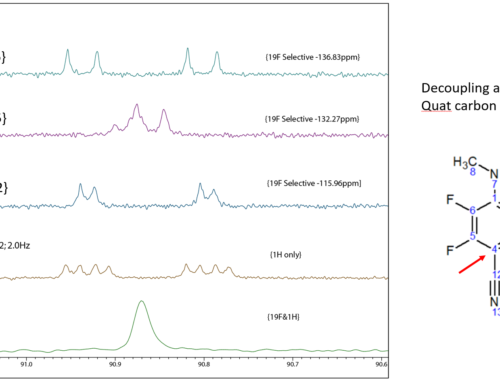Introduction
This post is a continuation of my older post titled: Background Suppression in Solid-State NMR – Part 1. In the first post, I explained the origin of probe background signal. I also provided examples of 1H, 13C and 19F solid-state NMR spectra with and without background signal suppression. Here, we are going to discuss the DEPTH, EASY and TRIP pulse sequences.
Why should you read this post? As I explained in the first post, it is important to be able to differentiate between probe background signal and real signal. First of all, you do not most likely want to wrongly assign a background signal to your sample. Further, it is useful to be aware of various background suppression techniques and be able to use them correctly.
Examples of Pulse Sequences for Background Suppression in Solid-State NMR
DEPTH
Bendall and Roby proposed the DEPTH pulse sequence to overcome limitations of surface coils. However, it was Cory and Ritchey who applied the DEPTH pulse sequence to background suppression in solid-state and solution NMR in 1988.
Some of standard JEOL pulse programs for solid-state NMR have an option to apply DEPTH. Two examples of such pulse programs are single_pulse_solid.jxp (MAS) and single_pulse_dec_solid.jxp (DDMAS). All you need to do is to check a checkbox to apply the DEPTH pulses. However, the JEOL implementation of DEPTH requires 16 scans for complete phase cycling, and hence multiples of 16 scans yield maximum background suppression. Indeed, this is not a problem when we are collecting a 13C signal on a sample at natural 13C abundance, because we typically collect hundreds or rather thousands of scans.
The advantages of DEPTH are its simple implementation, good compatibility with other pulse sequences and robustness. Fig 1. shows the DEPTH pulse sequence diagram.

Figure 1. DEPTH pulse sequence diagram
EASY (Elimination of Artifacts in NMR SpectroscopY)
This technique is very close to my heart, because I met professor Jaeger at a conference and discussed his poster. Later, Jaegar and Hemmann published the basic EASY pulse sequence and demonstrated various applications in 1D solid-state NMR. In the second article, they proposed additional 1D and 2D experiments employing the EASY approach. The advantage of EASY is that the pulse sequence suppresses probe background signal in a single scan. Moreover, it also suppresses acoustic ringing and dead time effects.
Fig. 2 shows the pulse sequence diagram of basic EASY. The first excitation pulse excites the signal of sample and the probe background signal. Then the second excitation pulse follows. However, please note that there is no relaxation delay after the first acquisition block. For this reason, the second excitation pulse excites the probe background signal almost exclusively, because the signal of sample does not have enough time to recover. Finally, the second FID is subtracted from the first FID, and hence the signal of background is suppressed.

Figure 2. EASY pulse sequence diagram
You may prefer EASY over DEPTH when you are collecting 1H or 19F MAS spectra. Actually, you can collect only one scan while enjoying the full potential of EASY background suppression. EASY is fairly compatible with other pulse sequences as was shown in the original papers. In addition to that, we have successfully combined the EASY pulse sequence with saturation recovery. I typically use this pulse program to collect 1H or 19F saturation recovery data using one scan whenever T1 does not need to be determined very accurately. As I have explained above, DEPTH would require 16 scans and much more time.
On the other hand, the EASY pulse sequence is not suitable for nutation experiments, because the efficiency of background suppression depends on flip angle.
TRIP (Triple-Pulse)
Wang et al. proposed the TRIP pulse sequence for background and acoustic ringing suppression in 2021. The paper prompted me to revisit the topic of background suppression, write the JEOL pulse program and write this post.
Fig. 3 shows the TRIP pulse sequence diagram. TRIP suppresses probe background and probe ringing like EASY. Unfortunately, it requires more scans for complete phase cycling than EASY. However, TRIP does not increase noise in the resulting spectrum while EASY does. In my hands, TRIP provides as good background suppression as DEPTH and EASY. Its main application is in solid-state NMR of quadrupolar and low-gamma nuclides. Unfortunately, like EASY, it is not suitable for nutation experiments.

Figure 3. TRIP pulse sequence diagram
Conclusion on Background Suppression in Solid-State NMR – Part 2
I have introduced three pulse sequences for probe background signal suppression in solid-state NMR. I have briefly discussed their advantages and disadvantages from my perspective. To make your choice easier, let me conclude:
- DEPTH is a classic in the field and works fine.
- With EASY and TRIP you also get acoustic ringing suppression as a bonus.
- A disadvantage of DEPTH and TRIP is their reliance on lengthy phase cycling. However, this is not a problem in the case of low-natural abundance nuclei (13C, 29Si, 15N, etc), low-sensitivity nuclei or very diluted samples.
You may want to read the first part of this post in which I explained the origin of probe background signal and showed examples.
And why not try JEOL JASON software for yourself? Discover how its advanced data processing and analysis tools make it easy to get great results from your datasets.
If you wish to know more about JEOL ECZ Luminous NMR spectrometers and JEOL solid-state NMR probes, click the links. A brochure on JEOL solid-state NMR is available here.



